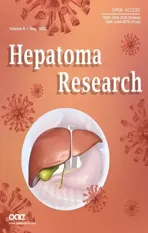Liver tumors in childre n
2022-03-11DanielAronsonPiotrCzauderna
Daniel C. Aronson, Piotr Czauderna
1(retired) Department of Paediatric Surgery, University Children’s Hospital Zürich, Zürich 8032, Switzerland.
2Department of Surgery and Urology, Children and Adolescents Medical University of Gdansk, Gdansk 80-803, Poland.
This issue of Hepatoma Research is dedicated to liver tumors in Children, which is a quite rare group of tumors. Although the majority of pediatric liver tumors are malignant (57%), its main contributors,hepatoblastoma (HB) and hepatocellular carcinoma (HCC), only have an incidence of 1.6 per 1 million children, thus comprising 5%-8% of all pediatric solid tumors.
Our goal has been to establish an issue for the journal that gives a state-of-the-art overview of some aspects of the current knowledge within this field. The paper of Armengolet al.[1]overviews some basic science,bridging molecular biology to the prognosis and treatment of HB. Surgical aspects are described by the literature review of Kościuszkoet al.[2], who give an overview of preoperative planning of liver tumor resections, Hiyamaet al.[3], who describe the consequences of marginal positive resection margins, and Calinescuet al.[4], who describe the role of liver transplantation in Pediatric HB and HCC. Weedaet al.[5]give an overview of where we stand with HCC, and Calinescuet al.[6]describe the surgical perspective of undifferentiated sarcoma of the liver.
The way forward in the approach to rare tumors is an international collaboration. It has been this international cooperation between the four major Pediatric Liver Tumor Study Groups in Europe, the USA,and Japan (SIOPEL/GPOH, COG, and JPLT) that formed the tipping point to create the Children’s Hepatic tumor International Collaborative (CHIC), leading to the establishment of a large international collaborative dataset, the CHIC database[7]. This database contains such a large data set, that its analysis allowed to establish a new universal risk stratification system for HB[8]. Concomitant international collaboration of pediatric pathologists made it possible to use the collected data to establish a new international histopathologic consensus classification for pediatric liver tumors as a whole, with particular focus on the histological subtypes of HB[9,10].
During the same period, advances in chemotherapy options developed, an increased role of liver transplantation for unresectable tumors was established, and a web portal system was created at www.siopel.org for international education, consultation, and collaboration. These achievements are currently further tested and validated in the running Paediatric Hepatic International Tumour Trial(PHITT).
This small collection of papers on this subject invites the interested reader to further explore the existing literature on the achievements in the field of Pediatric Liver Tumors that have been established during the past decades[11].
DECLARATIONS
Authors’ contributions
Editorial written: Aronson DC
Suggestions and changes added: Czauderna P
Availability of data and materials
Not applicable.
Financial support and sponsorship
None.
Conflicts of interest
All authors declared that there are no conflicts of interest.
Ethical approval and consent to participate
Not applicable.
Consent for publication
Not applicable.
Copyright
© The Author(s) 2022.
